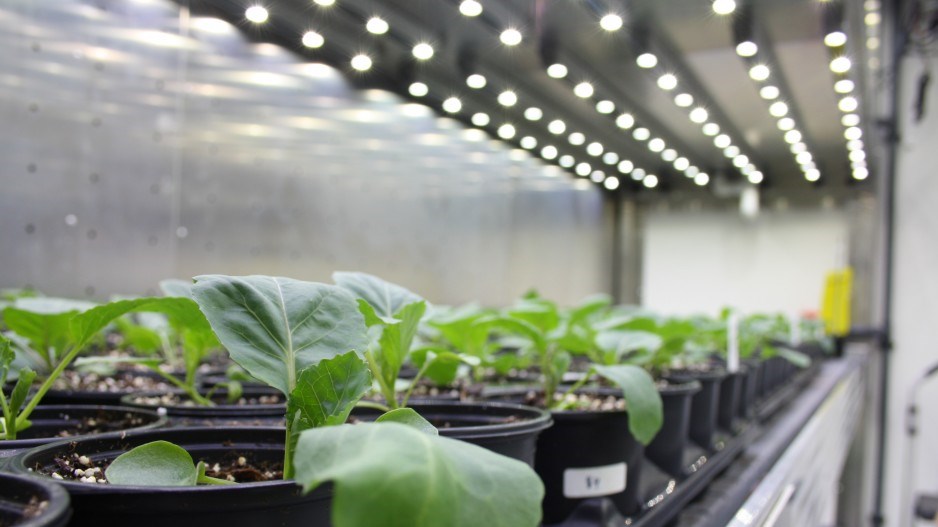Inside two industrial buildings – one a fading dark grey, the other a burnt-orange brick – sitting side by side in Mount Pleasant, CEO Karn Manhas sees “pretty cutting-edge” innovations on the precipice of changing agriculture over the next decade.
There, scientists at Terramera Inc. are running test after test on plants and pests to develop chemistry technology that improves the efficiency, uptake and performance of the active ingredients in crop-protection products.
The Vancouver company’s goal is to reduce synthetic chemicals used in agriculture globally by 80% by 2030 while increasing farm productivity by 20%.
“We can’t afford this industry not to be brought into the 21st century,” said Manhas, who founded Terramera in 2010.
Other players in the agriculture technology (agri-tech) space are also recognizing that conventional farming has not kept pace with rapid advances in technology.
Earlier this month Terramera and eight partners got backing from the Digital Technology Supercluster in Vancouver, which divided $20.4 million among six wide-ranging projects.
Terramera’s partnership with organizations including Compression.ai and Canada’s Michael Smith Genome Sciences Centre will see otherwise disparate groups collaborate to develop commercial products – tapping into everything from robotics to genomics in a bid to improve crop health.
“Part of the value is to be able to see how other industries are solving similar problems,” Manhas told Business in Vancouver the day the supercluster funding was announced.
“For us to have genomics facilities or all kinds of specialized facilities are quite costly, so to be able to partner with other organizations that can expand and extend our capabilities allows us to move much faster.”
Terramera chairman Jeff Booth, who was appointed the company’s board chairman after it raised US$45 million from investors last September, said the potential for agri-tech still remains untapped compared with other sectors.
It’s why Booth, perhaps best known as the co-founder and original CEO of e-commerce company BuildDirect Technologies Inc., also took on the chairmanship of agri-tech firm CubicFarm Systems Corp. (TSX-V:CUB) in late January.
The Langley-based company has developed automated hydroponic growing chambers that look like shipping containers and offer a controlled environment for growing crops and animal feed.
“It’s an untouched category,” Booth said.
CEO Dave Dinesen said the technology came to fruition after the CubicFarm Systems founders visited Puerto Rico and saw the need to grow produce in any location (the U.S. territory depends significantly on imports).
Dinesen said automation within the chambers reduces the amount of land needed for growing.
“It ticks all the good boxes and makes indoor growing economical,” he said. “Every 90 minutes, hundreds of trays of plants will pass by you so you can stand in one spot and do all of your harvesting and planting, and it lets us have much fewer lights than any other system, much less labour. And then because the machine brings everything to the worker at the front you don’t need to leave any access hallways for people, so we get far more yield than any other system.”
He said that for now most of the market is made up of the early adopters but he’s certain that farmers will have no choice but to start using new technologies to make farming more sustainable.
An August 2019 report from the Royal Bank of Canada (TSX:RY), meanwhile, forecasts multibillion-dollar growth potential for the country if farmers and companies can successfully seize on new technology.
The bank’s Farmer 4.0 study estimated that in Canada, where one-quarter of farmers will be 65 or older by 2025, the agricultural labour shortage is expected to grow to 123,000 positions by 2030. However, Royal Bank determined that the sector’s GDP output could grow from $40 billion to $51 billion over the next decade if the right investments are made in people, skills and technology.
The report also pointed out a number of deficiencies in technology adoption within the sector, including Canada’s 3.4% global share of agri-tech investments. That’s behind India and Brazil, despite Canada’s more abundant access to land, water and capital.
The bank is urging Ottawa to create a national skills strategy for agriculture and is calling on industry groups to attract and retain more youth, women and Indigenous workers to the sector to address those shortages.
For B.C. companies that have been commercializing products for years already, the play for agri-tech has been paying off.
SemiosBio Technologies Inc. develops wireless network technology for farms and orchards that helps create stronger yields by fighting pests and monitoring for diseases and harmful weather.
Three years ago Semios had 150,000 sensors and cameras deployed to monitor the health of trees that produce fruit or nuts.That has since grown to a million sensors, while reaching nearly 100% year-over-year market growth in the jurisdictions the company has been focused on – California, Washington state and Oregon.
“There’s a pressure on the farmers to improve their sustainability footprint,” said CEO Michael Gilbert, whose company’s devices can detect and identify agricultural pests and trigger the release of pheromones to confuse them and thwart their mating.
Preventing their spread this way curtails the use of pesticides that could be harmful to the environment.
To date, Semios has monitored and collected data on 30 million trees that produce fruit and nuts.
“Whenever you have a complex biosystem, because there’s so many factors at play, you need the numbers to see the trends and solve the problems,” Gilbert said. “So we’re finally at a place with a million sensors … that it’s really going to accelerate our understanding of why things happen.
“And I suspect that’s going to be a major competitive barrier to other incumbents coming in.”




